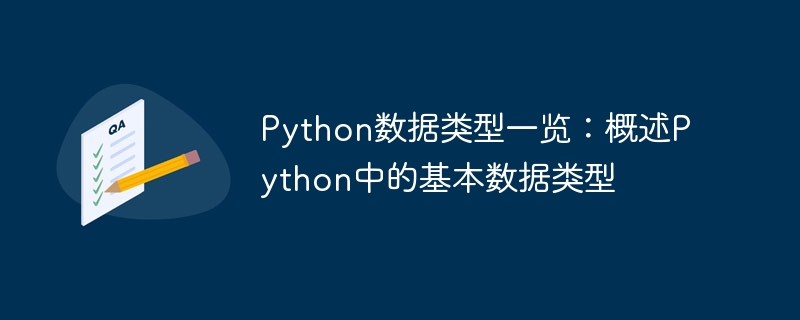Python の基本データ型の概要: Python のさまざまなデータ型を理解する

Python データ型の概要: Python の基本的なデータ型の概要、必要な特定のコード例
Python は、簡潔で柔軟で、習得が簡単です。幅広い分野で使われるプログラミング言語。 Python では、データの保存と処理にさまざまなデータ型が使用されます。この記事では、Python の基本的なデータ型の概要を説明し、読者の理解を助けるコード例を示します。
- 整数 (int) 型:
Integer は、Python で最も一般的に使用されるデータ型の 1 つで、小数部分を除いた数値を表すために使用されます。たとえば、1、3、(-5) はすべて整数です。次のコードを使用して、整変数を定義し、基本的な算術演算を実行できます。
num1 = 5 num2 = 3 sum = num1 + num2 difference = num1 - num2 product = num1 * num2 quotient = num1 / num2
- 浮動小数点 (float) 型:
浮動小数点数は、小数部分を持つ数値を表すために使用されます。たとえば、1.5、3.14 などはすべて浮動小数点数です。次のコードを使用して浮動小数点変数を定義し、基本的な算術演算を実行できます。
num1 = 1.5 num2 = 3.0 sum = num1 + num2 difference = num1 - num2 product = num1 * num2 quotient = num1 / num2
- String (str) タイプ:
String はテキスト データを表すために使用され、文字を含めることができます。 、数字、特殊文字など。 Python では、文字列を一重引用符または二重引用符で囲むことができます。たとえば、「Hello」と「World」は両方とも文字列です。次のコードを使用して、文字列変数を定義し、基本的な操作を実行できます。
str1 = 'Hello' str2 = "World" concatenation = str1 + str2 length = len(str1)
- リスト タイプ:
List は、さまざまなタイプの要素を含めることができる順序付き変数データ タイプです。次のコードを使用して、リストを定義し、基本的な操作を実行できます。
list1 = [1, 2, 3, 'four', 'five']
length = len(list1)
element = list1[0]
list1.append(6)
list1.remove('four')- Tuple (タプル) 型:
Tuple は、順序付けされた不変のデータ型であり、さまざまな型を含めることができます。要素。リストとは異なり、タプルは作成後に変更することはできません。次のコードを使用してタプルを定義し、基本的な操作を実行できます。
tuple1 = (1, 2, 3, 'four', 'five') length = len(tuple1) element = tuple1[0]
- 辞書 (dict) 型:
辞書は、キーで構成される順序付けされていない変更可能なデータ型です。値のペア。各キーと値のペアは、コロンで区切られたキーと対応する値で構成されます。次のコードを使用してディクショナリを定義し、基本的な操作を実行できます。
dict1 = {'name': 'Alice', 'age': 25, 'gender': 'female'}
length = len(dict1)
value = dict1['name']
dict1['age'] = 26- セット タイプ:
セットは、唯一の要素のみを含むことができる順序付けされていない可変データ型です。次のコードを使用して、コレクションを定義し、基本的な操作を実行できます。
set1 = {1, 2, 3, 4, 4, 'five'}
length = len(set1)
set1.add(5)
set1.remove(1)上記は、Python で一般的に使用される基本的なデータ型の概要と、基本的な操作のサンプル コードです。これらのデータ型をマスターすることで、データをより柔軟に処理および操作できるようになります。この記事が読者の Python でのデータ型の学習と使用に役立つことを願っています。
以上がPython の基本データ型の概要: Python のさまざまなデータ型を理解するの詳細内容です。詳細については、PHP 中国語 Web サイトの他の関連記事を参照してください。

ホットAIツール

Undresser.AI Undress
リアルなヌード写真を作成する AI 搭載アプリ

AI Clothes Remover
写真から衣服を削除するオンライン AI ツール。

Undress AI Tool
脱衣画像を無料で

Clothoff.io
AI衣類リムーバー

AI Hentai Generator
AIヘンタイを無料で生成します。

人気の記事

ホットツール

メモ帳++7.3.1
使いやすく無料のコードエディター

SublimeText3 中国語版
中国語版、とても使いやすい

ゼンドスタジオ 13.0.1
強力な PHP 統合開発環境

ドリームウィーバー CS6
ビジュアル Web 開発ツール

SublimeText3 Mac版
神レベルのコード編集ソフト(SublimeText3)

ホットトピック
 7532
7532
 15
15
 1379
1379
 52
52
 82
82
 11
11
 21
21
 82
82
 LinuxターミナルでPythonバージョンを表示するときに発生する権限の問題を解決する方法は?
Apr 01, 2025 pm 05:09 PM
LinuxターミナルでPythonバージョンを表示するときに発生する権限の問題を解決する方法は?
Apr 01, 2025 pm 05:09 PM
LinuxターミナルでPythonバージョンを表示する際の許可の問題の解決策PythonターミナルでPythonバージョンを表示しようとするとき、Pythonを入力してください...
 プロジェクトの基本と問題駆動型の方法で10時間以内にコンピューター初心者プログラミングの基本を教える方法は?
Apr 02, 2025 am 07:18 AM
プロジェクトの基本と問題駆動型の方法で10時間以内にコンピューター初心者プログラミングの基本を教える方法は?
Apr 02, 2025 am 07:18 AM
10時間以内にコンピューター初心者プログラミングの基本を教える方法は?コンピューター初心者にプログラミングの知識を教えるのに10時間しかない場合、何を教えることを選びますか...
 あるデータフレームの列全体を、Python内の異なる構造を持つ別のデータフレームに効率的にコピーする方法は?
Apr 01, 2025 pm 11:15 PM
あるデータフレームの列全体を、Python内の異なる構造を持つ別のデータフレームに効率的にコピーする方法は?
Apr 01, 2025 pm 11:15 PM
PythonのPandasライブラリを使用する場合、異なる構造を持つ2つのデータフレーム間で列全体をコピーする方法は一般的な問題です。 2つのデータがあるとします...
 中間の読書にどこでもfiddlerを使用するときにブラウザによって検出されないようにするにはどうすればよいですか?
Apr 02, 2025 am 07:15 AM
中間の読書にどこでもfiddlerを使用するときにブラウザによって検出されないようにするにはどうすればよいですか?
Apr 02, 2025 am 07:15 AM
fiddlereveryversings for the-middleの測定値を使用するときに検出されないようにする方法
 正規表現とは何ですか?
Mar 20, 2025 pm 06:25 PM
正規表現とは何ですか?
Mar 20, 2025 pm 06:25 PM
正規表現は、プログラミングにおけるパターンマッチングとテキスト操作のための強力なツールであり、さまざまなアプリケーションにわたるテキスト処理の効率を高めます。
 uvicornは、serving_forever()なしでhttpリクエストをどのように継続的に聞いていますか?
Apr 01, 2025 pm 10:51 PM
uvicornは、serving_forever()なしでhttpリクエストをどのように継続的に聞いていますか?
Apr 01, 2025 pm 10:51 PM
UvicornはどのようにしてHTTPリクエストを継続的に聞きますか? Uvicornは、ASGIに基づく軽量のWebサーバーです。そのコア機能の1つは、HTTPリクエストを聞いて続行することです...
 文字列を介してオブジェクトを動的に作成し、Pythonでメソッドを呼び出す方法は?
Apr 01, 2025 pm 11:18 PM
文字列を介してオブジェクトを動的に作成し、Pythonでメソッドを呼び出す方法は?
Apr 01, 2025 pm 11:18 PM
Pythonでは、文字列を介してオブジェクトを動的に作成し、そのメソッドを呼び出す方法は?これは一般的なプログラミング要件です。特に構成または実行する必要がある場合は...
 人気のあるPythonライブラリとその用途は何ですか?
Mar 21, 2025 pm 06:46 PM
人気のあるPythonライブラリとその用途は何ですか?
Mar 21, 2025 pm 06:46 PM
この記事では、numpy、pandas、matplotlib、scikit-learn、tensorflow、django、flask、and requestsなどの人気のあるPythonライブラリについて説明し、科学的コンピューティング、データ分析、視覚化、機械学習、Web開発、Hの使用について説明します。




